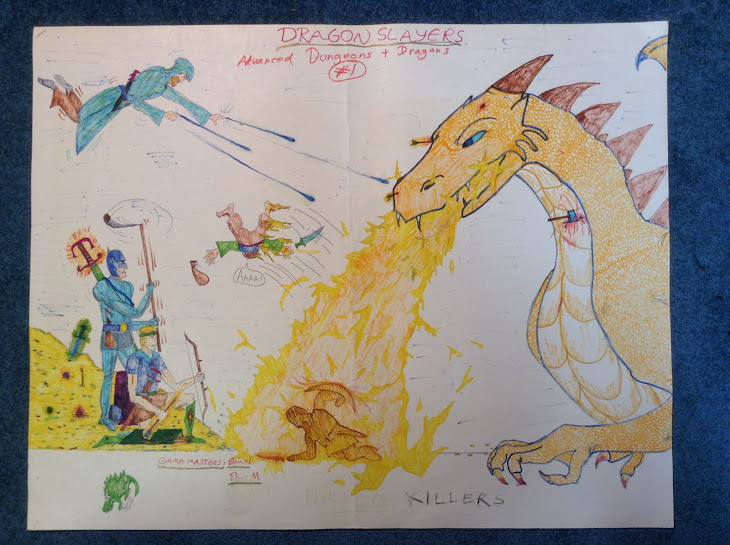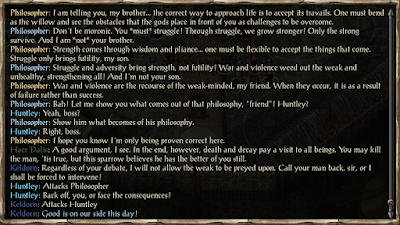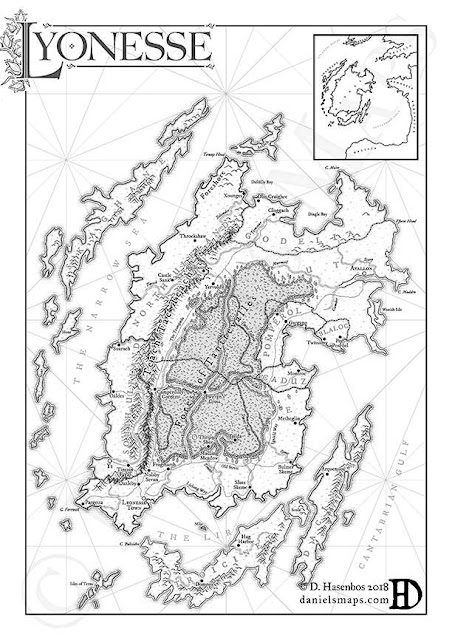Mid-late June 2946...
The companions leave Esgaroth with a caravan of four barges. The barges push up the Celduin River to trade with the Wood Elves. After 4 days of travel, the floating caravan reaches the Wood Elf town of Celebannon.
[Map of Celebannon from ICE's Mirkwood.]
The companions go to the only inn in town—‘Dindraug’—where they learn from the Elven traders that the spiders of Mirkwood have become more active in recent years, since the disappearance of the Necromancer. The forest goblins, on the other hand, have become less active during the same period.
Hengil visits the Sindarin scholar Luinwen’s abode. He asks the scholar to help him learn more about the black orb. She agrees, but tells the Dúnedan that it will take her several days of research.
Rothaar One-Leg, a scout and warrior in the employ of the Lake-town merchant Thal Eolsen, arrives at Dindraug early in the morning. He meets the party and informs them that his caravan has been ambushed by a band of goblins, working with a large creature. He does not know what the large creature is, as he was not with the caravan at the time of the ambush; instead, he was scouting the trail ahead of the caravan, and discovered the dead guards and wagon ruins upon his return. Rothaar believes that the goblins have taken at least one guard prisoner, as well as the loot from the wagon.
[Rothaar by Liz Danforth, from ICE's Denizens of the Dark Wood.]
The companions agree to help Rothaar, as does a young (rather eager and naïve) elf hunter named Galen. After Rothaar rests for a few hours and the heroes prepare themselves, the party departs Celebannon, heading southwest along the Elf-path.
In the late afternoon (June 22nd) the party reaches the ambush site. Hartmut identifies the tracks of the mysterious ‘large creature’ as those of a hill troll; the others belong to forest goblins. The beorning then leads the party to one of the hidden rest spots known to him in the region.
The next day Hartmut and Galen follow the tracks to small clearing; within the clearing, halfway up a rough hill, they two spot a dismal cave. The party convenes at the edge of the clearing; they spy a goblin lurking near the entrance to the cave. Hengil sneaks up to a bush halfway to the hill. There he makes a pheasant sound to draw out the goblin guard. The goblin leaves to investigate; it is promptly shot and slain by Hartmut and Ulvmund.
The company then approaches the cave. Alas, their attempt at stealth fails miserably, as the goblins inside are alerted and they ask the party something in the grotesque Orcish tongue. Unable to answer, the companions charge in to confront their nemeses. After a brief combat, the goblins flee further into the caves. The vile creatures are pursued—eventually a terrible struggle ensues. The goblins are promptly joined by a massive troll, which quickly knocks poor Galen unconscious. With his mighty axe, however, Hartmut manages to chop the troll to death.

[Another picture by Liz Danforth from ICE's Denizens of the Dark Wood.]
Following the desperate mêlée, the party discovers a concealed ‘chimney’—clogged with webs—that leads up and out of the cavern complex. Ulvmund also discovers a kind of ‘saddle’ strapped to the back of the troll. The companions deduce that the saddle is designed to enable a large spider to ‘ride’ the troll as a kind of mount—fortunately, and to the relief of all, there is no sign of the spider itself. After some careful exploration, Hartmut uncovers a finely crafted locked box—the prized possession of the merchant Thal Eolsen, taken from the caravan. Rothaar promises the party that the merchant will reward them greatly for the box’s return.
The party returns to Hartmut’s safe-hold and camps for the night. The following day they journey to Celebannon. During their trip, though, Ulvmund senses that the group is being followed. The Dale-man’s intuition is vindicated when Hartmut spots some spiders following them within the trees. Upon being discovered, the spiders retreat further into the forest. The party, badly battered by their fight with the goblins and troll, elect to return to the elven village rather than pursue the spiders.
The company spends a few days (June 24th – 27th) resting in Celebannon. Luinwen has completed her researches concerning the black orb. She gives Hengil the ‘Legend of Unlight’ (which concerns the poisoning of the Two Trees, Telperion and Laurelin):
The Tale of Ungoliant
…Therefore Melkor said to her: ‘Do as I bid; and if thou hunger still when all is done, then I will give thee whatsoever thy lust may demand. Yea, with both hands.’
A cloak of darkness she wove about them when Melkor and Ungoliant set forth: an Unlight, in which things seemed to be no more, and which eyes could not pierce for it was void.
Upon the mountain-top dark Ungoliant lay; and she made a ladder of woven ropes and cast it down, and Melkor climbed upon it … Then Melkor laughed aloud, and leapt swiftly down the long western slopes; and Ungoliant was at his side, and her darkness covered him.
And in that very hour Melkor and Ungoliant came hastening over the fields of Valinor, as the shadow of a black cloud upon the wind fleets over the sunlit earth; and they came before the green mound Ezellohar.
Then the Unlight of Ungoliant rose up even to the roots of the Trees, and Melkor sprang upon the mound; and with his black spear he smote each Tree to its core, wounded them deep, and their sap poured forth. But Ungoliant sucked it up, and going then from Tree to Tree she set her black beak to their wounds, till they were drained; and the poison of Death that was in her went into their tissues and withered them, root, branch, and leaf; and they died.
And still she thirsted, and going to the Wells of Varda drank them dry; but Ungoliant belched forth black vapours as she drank, and swelled to a shape so vast and hideous that Melkor was afraid.
The party bids farewell to Luinwen and Galen, and returns to Esgaroth with Rothaar.


































